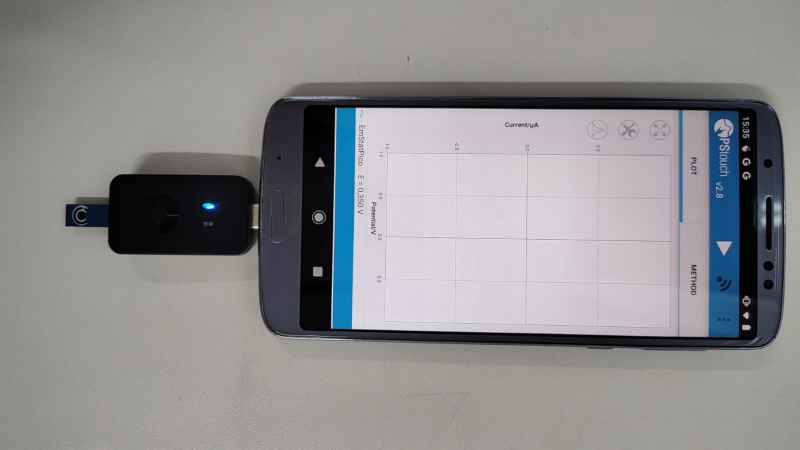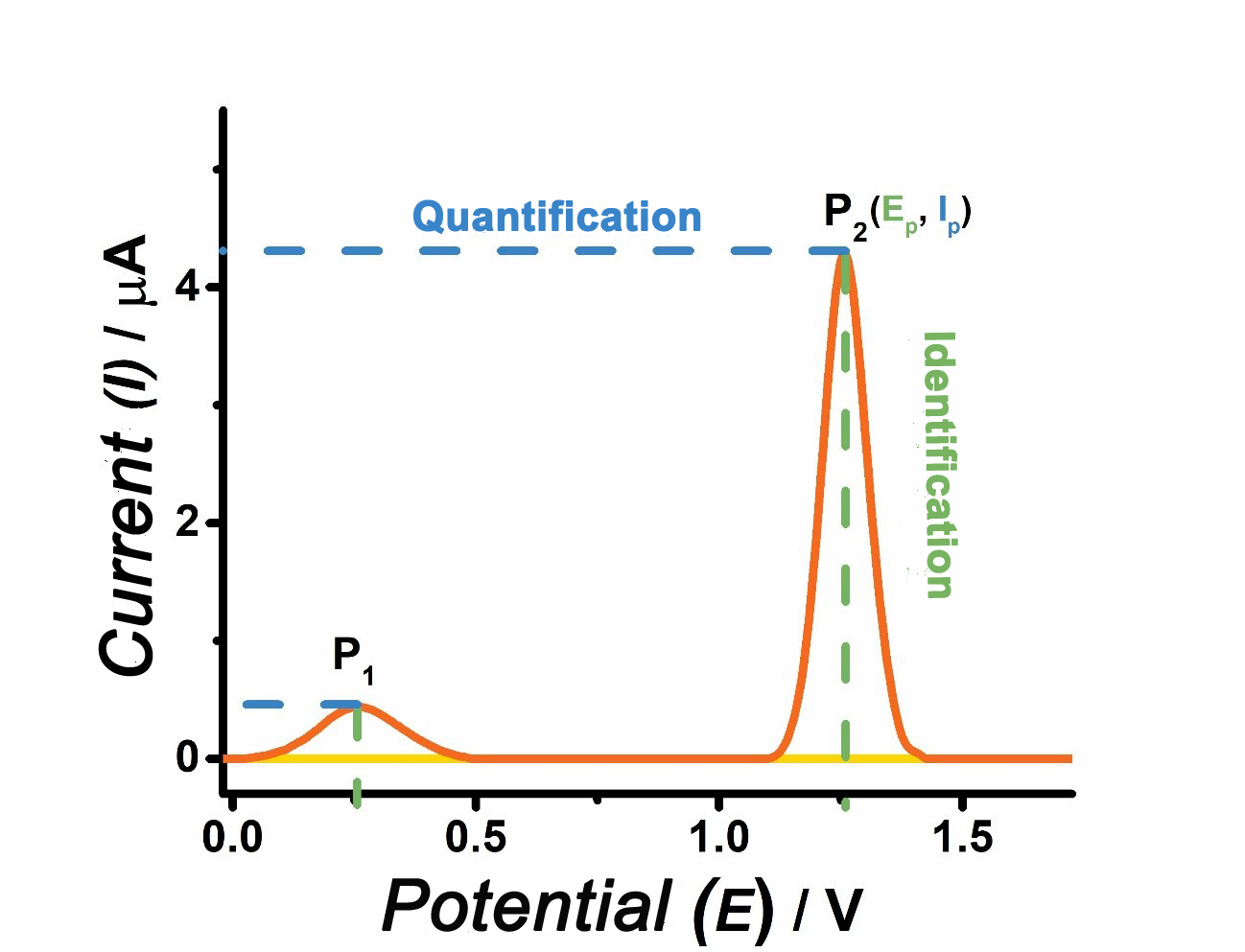

Device connected to a cell phone’s USB port: tested with the substances AB-Chminaca and MDMB-4en-Pinaca, two of the most common and dangerous synthetic cannabinoids, the device demonstrated its ability to detect very low concentrations (photo: Larissa Melo/INCT-SP)
Researchers develop technology that identifies highly potent and dangerous psychoactive substances. The device can be used in emergency medical facilities and to help inform users and reduce the harm associated with consumption.
Researchers develop technology that identifies highly potent and dangerous psychoactive substances. The device can be used in emergency medical facilities and to help inform users and reduce the harm associated with consumption.

Device connected to a cell phone’s USB port: tested with the substances AB-Chminaca and MDMB-4en-Pinaca, two of the most common and dangerous synthetic cannabinoids, the device demonstrated its ability to detect very low concentrations (photo: Larissa Melo/INCT-SP)
By José Tadeu Arantes | Agência FAPESP – Even though electronic cigarettes do not contain any illicit substances, the liquid can cause serious health problems. Often, the nicotine concentration in these products is several times higher than in conventional cigarettes, promoting rapid addiction. Furthermore, in countries like Brazil, which have banned electronic cigarettes, it Is observed that the products offered to users do not undergo any quality control. A resolution by the Brazilian Health Regulatory Agency (ANVISA) prohibits the manufacture, import, sale, distribution, storage, transportation, and advertising of electronic smoking devices.
“Some of these liquids contain up to 100 times more nicotine than a regular cigarette, whose legal maximum limit is 1 milligram of nicotine per cigarette. In addition, additives such as vitamin E acetate have been found in the liquids, which have caused deaths and permanent lung damage in users in the United States,” says Luciano Arantes, a researcher and member of the management committee of the Brazilian National Institute of Science and Technology on Psychoactive Substances (INCT-SP).
The scenario becomes even more concerning when considering the clandestine use of synthetic cannabinoids in these devices. These substances are created in laboratories to mimic the effects of tetrahydrocannabinol (THC), the main psychoactive component found in Cannabis sativa, or marijuana. However, synthetic cannabinoids are much more potent and can trigger neurological effects such as seizures, psychotic episodes, and even death from overdose.
“What we’re seeing is a chemical race. Clandestine groups are producing drugs with increasingly potent structures, requiring minimal doses to achieve the desired effect. As there’s no labeling or warning, users consume without knowing what they’re ingesting,” Arantes warns.
To address the problem, Brazilian researchers, in partnership with international colleagues, have developed a portable sensor that can accurately detect synthetic cannabinoids in e-cigarette liquids and biological fluids, such as saliva. The device is described in an article published in the journal Talanta.
“We developed an electrochemical method that identifies different synthetic cannabinoid molecules with high selectivity and sensitivity. The analysis can be done anywhere, with a small sample, and the sensor responds with a characteristic electrochemical signal,” describes Larissa Magalhães de Almeida Melo, the first author of the study, alongside student Cecília Barroso.
The device uses a boron-doped diamond electrode manufactured in collaboration with a group from the University of Technology in Bratislava, Slovakia. “It’s a simple system: the electrode is connected to a portable potentiostat, which can be connected to a cell phone via its USB-C port or even via a wireless Bluetooth connection. The response is a current-voltage graph, with specific peaks that identify and quantify the substances present,” Melo explains.
“This sensor represents a major innovation in the field of portable devices, as it combines the portability of printed sensors with the high stability of boron-doped diamond materials, which can be reused countless times,” emphasizes Wallans Torres Pio dos Santos, a professor at the Federal University of Vale do Jequitinhonha and Mucuri, in the Brazilian state of Minas Gerais, and coordinator of the study.
The sensor was tested with two of the most common and dangerous synthetic cannabinoids, AB-Chminaca and MDMB-4en-Pinaca. It demonstrated the ability to detect concentrations as low as 0.2 µM, even in the presence of high levels of nicotine and other interferences. In chemistry, µM (micromolar) is a unit of measurement for the concentration of a substance in solution. One µM is equal to one millionth of a mole per liter.
“The great advantage of our device is its selectivity. Even with the complexity of the samples, we were able to focus only on the substances of interest. It’s like entering a dark room and illuminating only the spot we want to observe,” Santos compares.
In addition to its use as a screening tool by forensic police, the device can be used in public health to provide emergency care to individuals experiencing overdoses or other complications, as well as for preventive harm reduction initiatives. To this end, the research group partners with the “BACO Project: Toxicology and Toxicological Analysis as Sources of Information for Drug Policy”. “The goal of this project is to evaluate the use of new psychoactive substances at parties and festivals by analyzing oral fluid samples. Our partnership with BACO researchers aims to extend the initial objective of the project to allow not only saliva analysis, but also the immediate screening of substances that partygoers intend to consume,” Arantes explains.
“These synthetic cannabinoids are constantly changing. New variants are emerging all the time, and many of them are extremely potent and dangerous. Our goal is to develop technologies that can be put into practice. We want users to know what they’re consuming and be able to make informed decisions. This can prevent serious poisoning and even save lives,” Melo points out.

Graph that allows the target substance present in the electronic cigarette to be identified and quantified (figure: Larissa Melo/INCT-SP)
“Our surveys show that 63% of users don’t know what they’re consuming. Many think they’re using a known drug, but in fact, they may be using a much more potent substance. By identifying the substance on the spot, the sensor gives users the chance to make an informed decision about its use. This alone reduces risks and saves lives,” Santos points out.
The adaptability of the method is another strength highlighted by the researchers. “We’ve already developed sensors for other classes of substances, such as LSD and its synthetic analogues, cathinones, and phenylethylamines. We’re also working on incorporating colorimetric reagents into the sensors to facilitate visual interpretation of the results,” Arantes explains.
FAPESP supports the project through research grants awarded to José Luiz da Costa of the State University of Campinas (UNICAMP) in the state of São Paulo, Brazil, who is a toxicology expert and partner in the group. Part of the analysis was done in collaboration with his laboratory, using real saliva samples collected in environments where the products are used.
“The saliva samples used in the study were collected as part of the BACO Project, developed at UNICAMP in partnership with the Ministry of Justice and Public Security [MJSP]. This project, in turn, is an offshoot of the research ‘The Toxicology of New Psychoactive Substances (NPS): Epidemiology of Consumption through the Analysis of Hair and Oral Fluid Samples’, also supported by FAPESP, in which we conducted the first epidemiological survey in Brazil on NPS at parties and festivals. Based on the results of this research, the MJSP decided to support and expand the study, allowing for a much larger number of samples to be collected, from 500 samples in the initial project to 2,500 in the current one. This allowed us to form new partnerships, including this one with Professor Wallans’ group,” says Costa.
“The goal is to take science where it can have a direct impact. Experts, doctors, and health professionals need accessible, fast, and reliable tools to face the challenges posed by new drugs. What we propose is a practical, portable, and scalable solution,” Arantes summarizes.
The article “A novel electrochemical method for detecting synthetic cannabinoids in e-cigarette and biological samples using a lab-made electrode” can be read at www.sciencedirect.com/science/article/abs/pii/S0039914025010641.
Republish
The Agency FAPESP licenses news via Creative Commons (CC-BY-NC-ND) so that they can be republished free of charge and in a simple way by other digital or printed vehicles. Agência FAPESP must be credited as the source of the content being republished and the name of the reporter (if any) must be attributed. Using the HMTL button below allows compliance with these rules, detailed in Digital Republishing Policy FAPESP.





